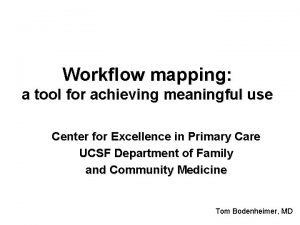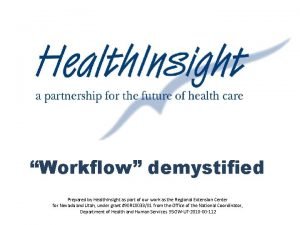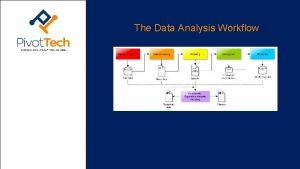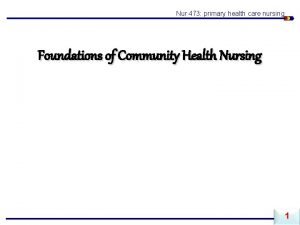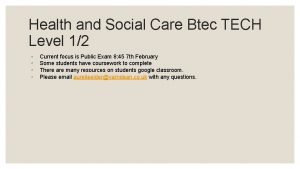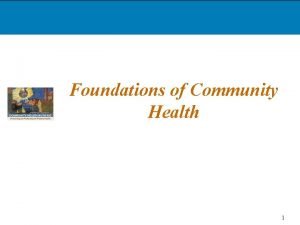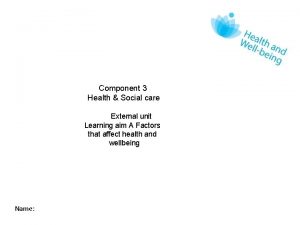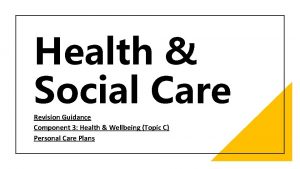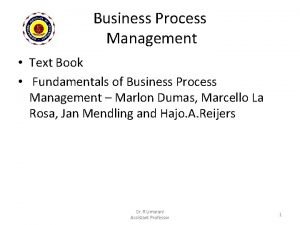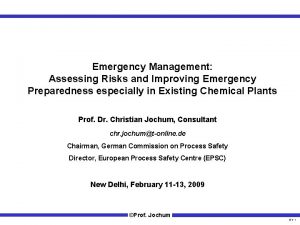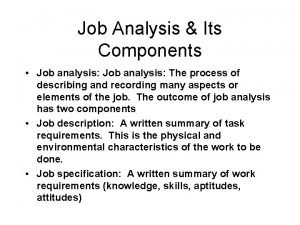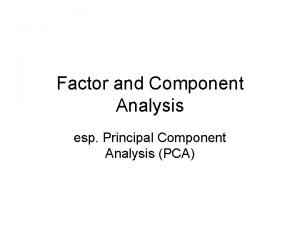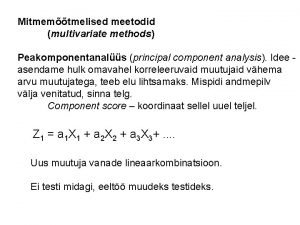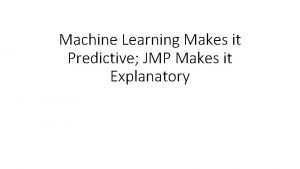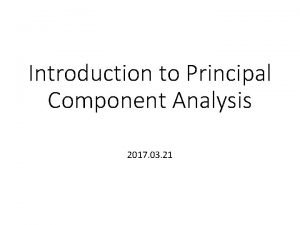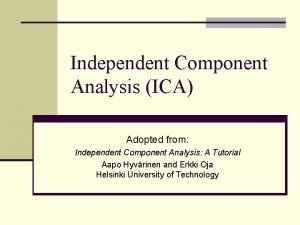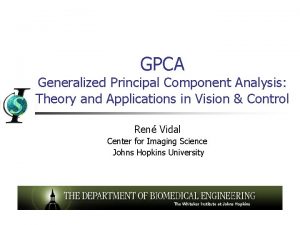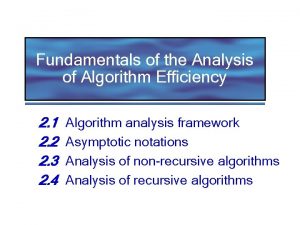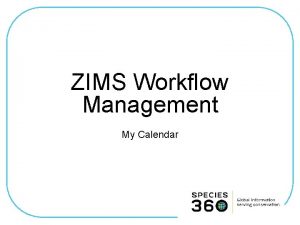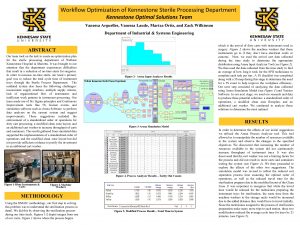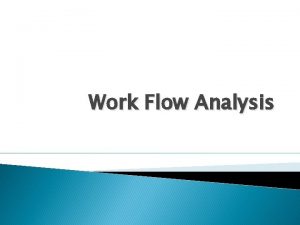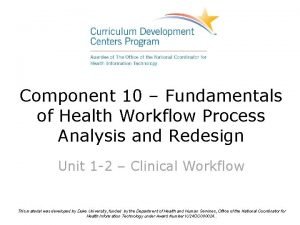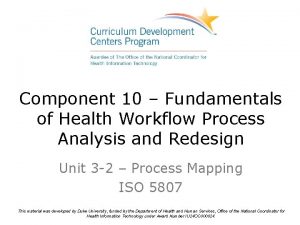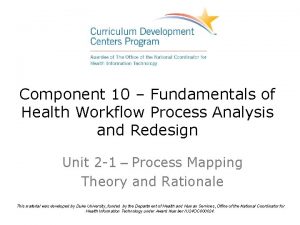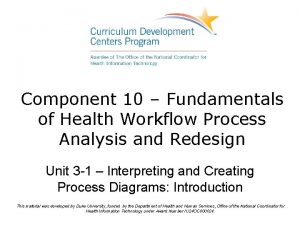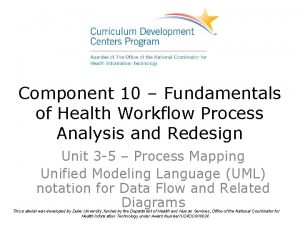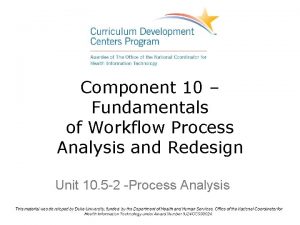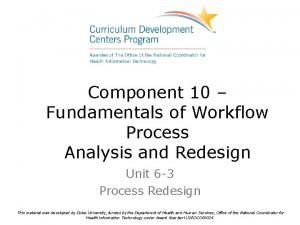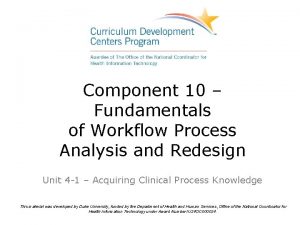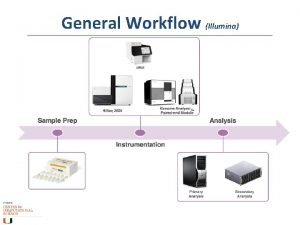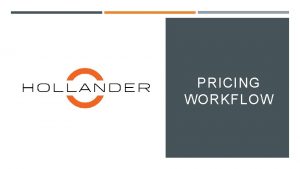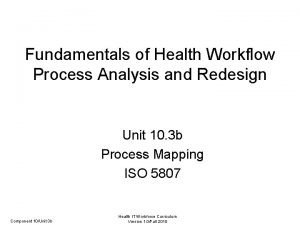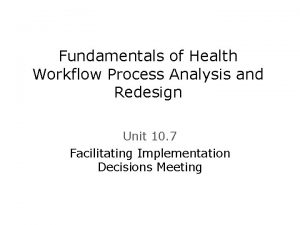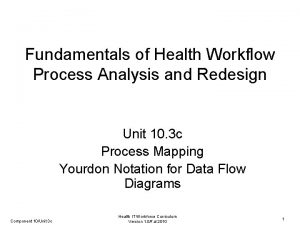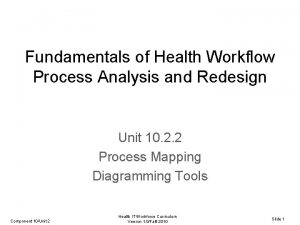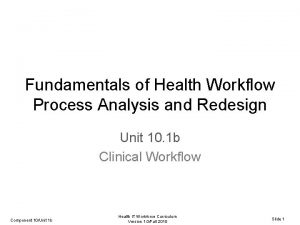Component 10 Fundamentals of Health Workflow Process Analysis





























- Slides: 29

Component 10 – Fundamentals of Health Workflow Process Analysis and Redesign Unit 11 – Maintaining and Enhancing Improvements This material was developed by Duke University, funded by the Department of Health and Human Services, Office of the National Coordinator for Health Information Technology under Award Number IU 24 OC 000024.

Unit Objectives Upon successful completion of this unit, you should be able to: 1. Design control strategies for clinic processes 2. Develop and present a sustainability and continuous improvement plan for a healthcare setting 3. Work with practice staff to develop a set of plans to keep the practice running if the EHR system fails. 4. Work with practice staff to evaluate the new processes as implemented and identify problems and changes that are needed Component 10/Unit 11 Health IT Workforce Curriculum Version 2. 0/Spring 2011 2

Topics – Unit 10. 11 • CQI • Process Control • Business Continuity Plan – Natural Disaster – Pandemic – Downtime Component 10/Unit 11 Health IT Workforce Curriculum Version 2. 0/Spring 2011 3

Sustainability • Important • Realize full potential • Organizational metrics and methods Component 10/Unit 11 Health IT Workforce Curriculum Version 2. 0/Spring 2011 4

CQI • The philosophy of continual improvement of the processes associated with providing a good or a service that meets or exceeds customer expectations, in this case, the service of quality health care • Adds an emphasis on understanding and improving the underlying work processes and systems in order to add value Component 10/Unit 11 Health IT Workforce Curriculum Version 2. 0/Spring 2011 5

CQI To achieve continuous quality improvement “it is not enough to do your best …” Component 10/Unit 11 Health IT Workforce Curriculum Version 2. 0/Spring 2011 6

QI Sustainability Motivators • Increase ability to achieve collaborative goals – More release time (60%) – Additional money (39%) • Other important motivators were: – – Improving the quality of care Professional development Personal recognition Personal satisfaction • Relatively few respondents were motivated by: – Career promotion opportunities (10%) – Fear of negative consequences (18%) Component 10/Unit 11 Health IT Workforce Curriculum Version 2. 0/Spring 2011 7

QI Sustainability Challenges • Time burden of collecting data during initial QI implementation • Funding • Personnel or Staff Turnover (loss of memory of changes) • Decreasing interest and enthusiasm over time Component 10/Unit 11 Health IT Workforce Curriculum Version 2. 0/Spring 2011 8

Tips for promoting a culture of quality improvement • • Educate staff about QI Set a routine schedule for reviewing data Communicate results from improvement projects Display data where patients can see them Celebrate successes Articulate the values of QI in meetings Provide opportunities for all staff to participate in QI teams • Reward staff members in their performance evaluations Component 10/Unit 11 Health IT Workforce Curriculum Version 2. 0/Spring 2011 9

Improvement Worksheet Topics • Primary goal and completion date – Secondary goals and completion dates • Process problem areas to address (n) – – – Potential causes Most likely causes Root cause Ways to streamline the process Ways you can modify the process Component 10/Unit 11 Health IT Workforce Curriculum Version 2. 0/Spring 2011 10

EHR and Quality Improvement • Data systems that automatically capture and track key clinical information, specifically the metrics of improvement and here the “meaningful use” criteria will make the QI process more efficient and potentially less costly • These systems typically require significant initial financial and social investment Component 10/Unit 11 Health IT Workforce Curriculum Version 2. 0/Spring 2011 11

Quality Council • • Establish core quality standards Identify quality metrics Identify and define quality requirements Clarify which performance measures are key to gauging actual quality improvement performance Collect and analyze data to understand key variables and process drivers Legitimize value of QI to ensure best use of resources and measure improvement associated with these activities Standardize collection and analysis of quality trends Educate organization and train key staff Component 10/Unit 11 Health IT Workforce Curriculum Version 2. 0/Spring 2011 12

Process Control • Process control (PC) is a statistics and engineering discipline that deals with architectures, mechanisms, and algorithms for controlling the output of a specific process • Statistical process control (SPC) is the application of statistical methods to the monitoring and control of a process to ensure that it operates at its full potential to produce conforming product Component 10/Unit 11 Health IT Workforce Curriculum Version 2. 0/Spring 2011 13

Challenges to SPC in Healthcare • SPC is now transferring into Healthcare • SPC was first used in manufacturing industry • SPC is not frequently included in books on medical statistics • SPC is a way of thinking which challenges many of our fundamental assumptions about how to deliver improvement Component 10/Unit 11 Health IT Workforce Curriculum Version 2. 0/Spring 2011 14

Statistical Process Control • Key tools in SPC – Control charts – A focus on continuous improvement and designed experiments • Examines a process and the sources of variation in that process • Reduces waste • Reduces the time required to produce the product or service from end to end Component 10/Unit 11 Health IT Workforce Curriculum Version 2. 0/Spring 2011 15

Statistical Process Control • Statistical Process Control activities – Understanding the process – Understanding the causes of variation – Elimination of the sources of special cause variation • Monitored using control charts to identify variation due to special causes • Causes for excessive variation must be determined – Designed experiments – Pareto charts Component 10/Unit 11 Health IT Workforce Curriculum Version 2. 0/Spring 2011 16

Features of a Control Chart • Simplicity • Retain information in the data by plotting – Ease of communication associated with (good) graphs – Incorporating statistical thinking • Provide guide for continual action – For common and special cause variation. • Provide reminder that gains lie in reducing common cause variation • Overcome the fundamental limitations and negative consequences of comparison with standards Component 10/Unit 11 Health IT Workforce Curriculum Version 2. 0/Spring 2011 17

Examples of CONTROL CHARTS Component 10/Unit 11 Health IT Workforce Curriculum Version 2. 0/Spring 2011 18

Control Chart of Surgeon Specific Hazard Ratios 3 Graph from Mohammed M A Qual Saf Health Care 2004; 13: 243 -245. Reproduced and distributed with permission from BMJ Publishing Group Ltd. Component 10/Unit 11 Health IT Workforce Curriculum Version 2. 0/Spring 2011 19

Control Chart of Surgery to Non-surgery Ratio Graph from Battersby J et al. J Epidemiol Community Health 2004; 58: 623 -625. Reproduced and distributed with permission from BMJ Publishing Group Ltd. Component 10/Unit 11 Health IT Workforce Curriculum Version 2. 0/Spring 2011 20

Business Continuity Plan Public domain photographs, Thunder at Saitama, by masaki ikeda. A fire in Massueville, by Sylvain Pedneault, and Union City Ok tornado by Steve Tegtmeier Obtained from http: //commons. wikimedia. org/. Component 10/Unit 11 Health IT Workforce Curriculum Version 2. 0/Spring 2011 21

Business Continuity • • Business Continuity Plan BCP Team BCP Objectives BCP Goals Essential Functions Critical Processes Exercises for Success Component 10/Unit 11 Health IT Workforce Curriculum Version 2. 0/Spring 2011 22

BCP Team • Assemble Core Team to oversee BCP development • Identify BCP Points-of-Contact for organizational units • Define the overarching BCP program • Develop a BCP timeline Public domain photograph obtained from http: //commons. wikimedia. org/. Component 10/Unit 11 Health IT Workforce Curriculum Version 2. 0/Spring 2011 23

BCP Plan Objectives • Ensure continuous performance of an organization’s • • • mission essential functions in an emergency Ensure safety of employees Protect essential equipment, records, and other assets Reduce disruptions to operations Minimize damage and losses Achieve an orderly recovery from emergency operations Identify alternate locations and ensure operational and managerial requirements are met before an emergency occurs. Component 10/Unit 11 Health IT Workforce Curriculum Version 2. 0/Spring 2011 24

Key BCP Plan Goals • Essential organizational functions, vital systems, data • • • and information identified and prioritized Critical elements capable of being recovered quickly to resume operations People know who is in charge Back-up personnel are trained Alternate work locations are predefined Checklists are predefined to guide the organization in responding to an emergency Component 10/Unit 11 Health IT Workforce Curriculum Version 2. 0/Spring 2011 25

Essential Functions that must be performed to achieve the organization’s mission • Essential Functions include: – – – Communications Vital Records, Systems and Equipment Key Personnel Alternate Work Sites Testing, Training & Exercises Component 10/Unit 11 Health IT Workforce Curriculum Version 2. 0/Spring 2011 26

Critical Processes or services that must be recovered within 24 hours after a disruption to ensure resumption of the essential function • Includes all resources necessary to carry out the critical process: – Personnel – Data or vital records – Systems and equipment • Component 10/Unit 11 Health IT Workforce Curriculum Version 2. 0/Spring 2011 27

Exercise for Success • Exercises are events that allow participants to apply their skills and knowledge to improve operational readiness • Goal of exercises is to prepare for a real incident involving BCP activation • Three types of exercises: – Tabletop – Functional – Full-scale Component 10/Unit 11 Health IT Workforce Curriculum Version 2. 0/Spring 2011 28

References 1. 2. 3. 4. 5. Shortell, Stephen M. , Bennett, Charles, L. and Byck, Gayle, R. , Assessing the Impact of Continuous Quality Improvement on Clinical Practice: What It Will Take to Accelerate Progress. Chin, Marshall H. , et al, Sustaining Quality Improvement in Community Health Centers: Perceptions of Leaders and Staff, J Ambul Care Manage. 2008; 31(4): 319– 329 Mohammed, M A, Using statistical process control to improve the quality of health care, Editorial in Statistical process control, Quality and Safety in Health Care 2004; 13: 243 -245 http: //www. businessdictionary. com/definition/business-continuityplan. html#ixzz 1385 PXd 8 E Battersby, J. , Flowers, J. , Harvey, I. , An alternative approach to quantifying and addressing inequity in healthcare provision: access to surgery for lung cancer in the east of England Epidemiology and Community Health, Theory and methods 2004; 58: 623 -625 Component 10/Unit 11 Health IT Workforce Curriculum Version 2. 0/Spring 2011 29
 Health and social care component 3 health and wellbeing
Health and social care component 3 health and wellbeing Workflow process mapping for ehr implementation
Workflow process mapping for ehr implementation Workflow analysis
Workflow analysis Analysis workflow
Analysis workflow Component of community health nursing
Component of community health nursing Btec
Btec Introduction of community health nursing
Introduction of community health nursing Health and social care component 2 learning aim b example
Health and social care component 2 learning aim b example Component of health assessment
Component of health assessment Component 3 health and wellbeing
Component 3 health and wellbeing Understanding your health and wellness chapter 1
Understanding your health and wellness chapter 1 Chapter 1 health and wellness fundamentals
Chapter 1 health and wellness fundamentals Shell 3 golden rules
Shell 3 golden rules Bpm phases
Bpm phases Fundamentals of business process management dumas
Fundamentals of business process management dumas Epsc process safety fundamentals
Epsc process safety fundamentals Component matrix spss
Component matrix spss Job analysis and its components
Job analysis and its components Pca and ica
Pca and ica Principal component analysis
Principal component analysis Principal component analysis jmp
Principal component analysis jmp Generalized principal component analysis
Generalized principal component analysis Principal component analysis
Principal component analysis Independent component analysis tutorial
Independent component analysis tutorial Generalized principal component analysis
Generalized principal component analysis Hilbert space
Hilbert space Fundamentals of analysis of algorithm efficiency
Fundamentals of analysis of algorithm efficiency Workflow management with calendar
Workflow management with calendar Instrument processing optimization
Instrument processing optimization Sterling baldwin
Sterling baldwin

